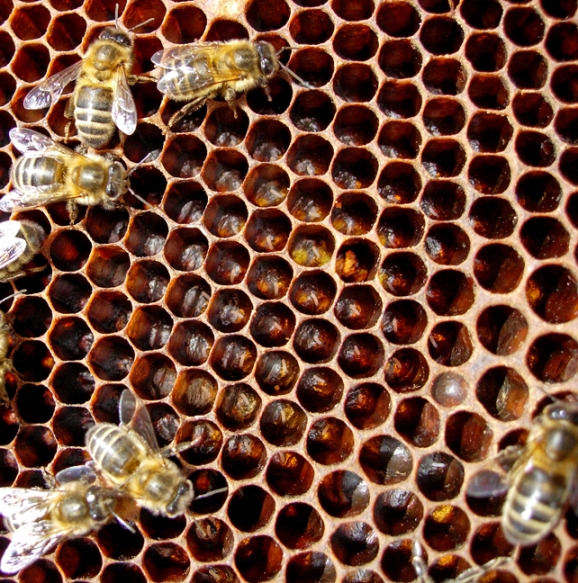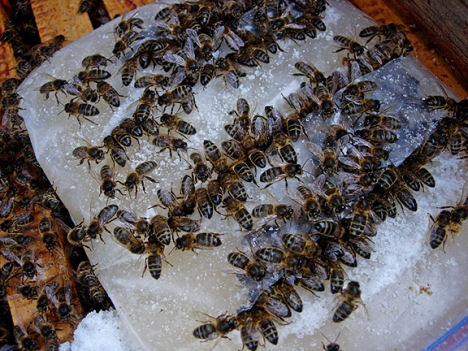Many beekeepers in the UK are having problems with queens: virgin queens fail to mate, disappear on mating flights or mate successfully, only to become drone-layers within weeks. I had a good queen-rearing season and bred 6 new queens – all of which mated successfully – and all produced fertile eggs and good brood-patterns over a number of frames. However, three of these queens were superseded (replaced) by the bees within a month – which is highly abnormal; it is however a phenomenon being seen up and down the country. Normally, a newly mated young queen would be good for at least two years, possibly three or even four – though most beekeepers try to replace their queens annually these days. However, many beekeepers are reporting that young, apparently vigorous and fertile queens are being killed by their own workers and replaced with new queens within a matter of weeks; this is highly abnormal behaviour and indicates that something is going terribly wrong.
My own hypothesis is that we are seeing the results of bio-accumulation of neo-nicotinoid pesticides in young queens which are affecting their behaviour in sub-lethal ways. French research by Dr Bonmatin at Montpelier University in 1998-99 revealed that the neo-nicotinoid pesticide Imidacloprid kills bees when they ingest it at levels of just 3-5 parts per billion (ppb)however, his team also found sub-lethal effects at far lower levels of contamination – a mere 0.1 ppb – an almost infinitesimally small level of poison. This independent research dramatically conflicted with that of Bayer- the manufacturers of Imidacloprid – who initially claimed that their new nerve-poison only killed bees at levels in excess of 50,000 ppb; they revised this downward to 10,000, then 5,000, then 1000 – and latterly – in the face of mounting evidence they have said that it kills bees at 50-100 ppb. Bonmatin’s research still claims that it kills bees at 5 ppb.
Why might Pesticides be Affecting Queen Bees?
Well, a worker bee only lives for 6 weeks – and sometimes less, depending on how hard it has to work in the field. So in its short life, it only eats pollen and nectar for this limited period. However, a queen bee lives for up to two years, and while a queen larva is growing in its cell, it is fed far more food than a worker larva. So if pesticides are present in the pollen and nectar which is used to feed a developing queen-larva, it will bio-accumulate far more pesticide than a worker-larva. The levels may still be sub-lethal but since these are neuro-toxins, they affect the nervous system and brain first – which control all complex queen-activities such: as the mating-flight, navigation to and from the hive, mating on the wing, laying eggs and so on. Moreover, the nervous system controls the production of pheromones by the queen, which affect all activities in the hive.
The queen bee regulates virtually all the activities of the hive through her production of queen-pheromones, sometimes called ‘queen substance’. In reality the ‘queen substance’ is made up of a dozen or more distinct pheromones, each of which plays a vital role in the governance of the hive. One vital pheromone for example suppresses the urge of the worker bees to produce queen cells – and hence make new queens; as the queen gets older, she produces less and less of this substance and at the same time, the population of the hive increases to perhaps 50,000 workers – so there is less and less inhibiting chemical to go around. When the ‘queen-cell-inhibition’ pheromone drops below a certain threshold, the workers cease to be repressed and they suddenly start to make new queen cells and new queens.
However, if the queen loses her potency in terms of any of the 20 or so pheromones which she creates and distributes in the hive, the bees will sense that ‘somethng is wrong’ and they may kill and replace her.
In addition, if the queen’s nervous system is damaged in any way that affects her behaviour, her egg-laying pattern for example – the bees will kill and replace her. There have been reports from France and from America that while bee-colonies have died by the thousands in areas where pesticides are routinely used on sunflowers, oilseed rape, almonds, apples, peas, beans and so on – there have been virtually no bee-losses in areas where such pesticides are not used: forests, heather-moorlands, offshore islands, mountain districts.
I recently read about a beekeeper called Andrew Abrahams who keeps native black bees on the remote island of Colonsay in the inner Hebrides:
http://www.colonsay.org.uk/
His bees forage on the wildflowers of the ‘Machair’ – the famed coastal flower-pastures which thrive because of the calcareous shell-sands created from billions of sea-shells ground by the Atlantic waves. The Machair habitat is found on many West-facing shores of most of the Hebridean islands and the vast carpet of wildflowers feeds millions of insects in May, which in turn attract thousands of migrant wading birds to breed here.
Since there is no intensive, pesticide-based farming on islands like Colonsay, the bees are uncontaminated – and the varroa mite has not reached the islands either, he writes: http://www.colonsay.org.uk/honey2.html
Industrial farming has laid waste the natural bee forage of most of Britain. Hedges uprooted, every weed sprayed, grasslands fertilised by nitrogen instead of clover. Only now at the margin, in places such as Colonsay, can a wide diversity of wildflowers still be found. Colonsay and Oronsay have varied habitats from the machair near the shore, to non intensive farmland, hedges, woodland and open heather moorland. Over 50% of all British wildflower species grow in this small area. A very mixed and varied feast for the bees!. The important nectar flows that make the bulk of the honey are sycamore and bluebell in the Spring, hawthorn, bramble and clover in the summer months and then the bell and ling heathers of the autumn. But it is the fragrant nectar of the numerous wildflowers that gives Isle of Colonsay Wildflower Honey it’s unique and special flavour. The strong aromatic oils of the wild thyme, growing on the sandy machair, are just one example.
A Queen from Over the Sea
I contacted Andrew to see if I could buy one of his Colonsay Queens to create a new colony at my Apiary in the Borders, and was lucky to find that he did have some queens for sale. The new queen would be sent through the post in a small plastic cage, protected in bubble-wrap and accompanied by a dozen or so attendant bees, with a block of honey-candy as food for the journey
The new queen would arrive a couple of days later but I had to prepare a nucleus hive of queenless bees to receive the new queen. This is a tricky procedure, since it involves taking bees from a hive which already has a queen and separating these bees from their mother-queen, whose pheromones are the very basis of their survival. Each queen has its own distinct pheromone-character and each hive of bees has its own ‘family-smell’; the bees will fight and kill any strange bee which attempts to enter their hive, because it does not have the right smell. So, in order to get bees to accept a new queen, with a new smell, they first have to be made queenless, by separating them from their mother-hive for at least 24 hours.
Queenless bees realise they are queenless within an hour or so, and they display all the classic signs: all normal activity in the hive stops and the bees run about all over the front of the hive in a disordered, frantic mob – ‘roaring’ loudly all the time. This noisy-chaos is unlike any other sight you will ever see around a beehive, and once seen it is never forgotten.
Having left this newly-made colony queenless overnight, I introduced the queen in her cage between the frames of the hive at dusk the next day.
-

-
Queenless Bees frantically searching for their queen
-

-
Queen Introduction Cage attracts bees
The effect was dramatic; within two minutes the noisy roaring died away, the frantic searching hither and thither stopped, and all the bees on the front of the hive trooped inside in an orderly manner. As soon as the queen was introduced into the hive, signal-bees appeared on the landing board where they stuck their tails in the air and exposed the white Nasonov Gland which is normally concealed beneath their tail segment. This exudes a ‘homing-pheromone’ which essentially signals that ‘this is home, everything is alright, come on in’.
Within minutes there was hardly a bee in sight and the Island Queen was being feted as the new mother of a new bee-colony; all that could be heard from the hive was the deep, contented hum of happy bees, which is one of the wonderful sounds of the world.
So I now have a new queen from a pesticide-free island, heading up a new colony in my apiary. The only problem of course is that I live in the Scottish Borders, in a centre of intensive, industrial, pesticide-laced arable farming. So the question is – ‘how long will she last?‘.





















